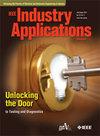Harmonic Loss Reduction of Fractional Slot Concentrated Winding Permanent-Magnet Vernier Motor With Different Stator-Modular Designs
IF 4.2
2区 工程技术
Q2 ENGINEERING, ELECTRICAL & ELECTRONIC
引用次数: 0
Abstract
Permanent-magnet vernier (PMV) motor is well-known for its distinctive performances of high torque at low speeds, making it suitable for direct drive application. However, the rich harmonics lead to the high loss and low efficiency of motor system. To suppress the harmonic loss, a stator modular design concept is proposed for fractional slot concentrated winding PMV motor. First, the precondition that the motor meets the stator modular design is derived, and according to this, a variety of options for modular design are expounded, including uniform or hybrid modular designs and tooth or yoke modular designs. Then, the harmonic distributions of PM field, armature reaction field, and harmonic loss of PMV motor with fractional slot concentrated winding (FSCW) are discussed. Based on analytical analysis and finite element analysis, the inhibitory effect of modular design method on the amplitude of the harmonic with low pole pair number in the motor armature reaction field is verified. Through comparison, it is found that the proposed stator modular design method can suppress motor losses without reducing output performance. Finally, a PMV motor with modular stator is processed and tested to verify the analysis.求助全文
约1分钟内获得全文
求助全文
来源期刊

IEEE Transactions on Industry Applications
工程技术-工程:电子与电气
CiteScore
9.90
自引率
9.10%
发文量
747
审稿时长
3.3 months
期刊介绍:
The scope of the IEEE Transactions on Industry Applications includes all scope items of the IEEE Industry Applications Society, that is, the advancement of the theory and practice of electrical and electronic engineering in the development, design, manufacture, and application of electrical systems, apparatus, devices, and controls to the processes and equipment of industry and commerce; the promotion of safe, reliable, and economic installations; industry leadership in energy conservation and environmental, health, and safety issues; the creation of voluntary engineering standards and recommended practices; and the professional development of its membership.
 求助内容:
求助内容: 应助结果提醒方式:
应助结果提醒方式:


